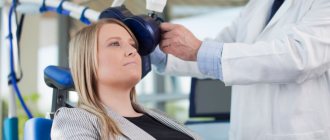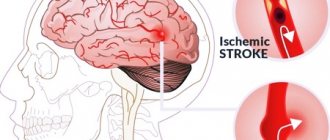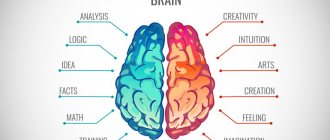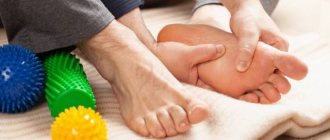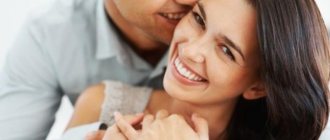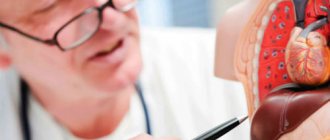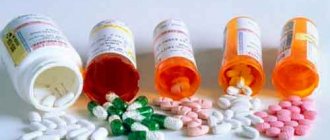Patients who have suffered a stroke involuntarily wonder how serious their injury is and whether it depends on the side of the lesion.
The following types of stroke changes are distinguished:
- Hemorrhagic (bleeding).
- Ischemic (changes due to blockage of the bloodstream by a thrombus).
- Mixed (a combination of thrombosis and vessel rupture).
The main damaging factor in any type is a direct disruption of the blood supply. It occurs due to damage to a vessel that supplies a certain part of the brain. Depending on what functions it is responsible for, certain disorders will develop.
General cerebral symptoms appear regardless of the location of the damaged area.
These include:
- severe headache;
- disturbance of consciousness, from transient to comatose;
- disturbance of orientation in time and space;
- convulsive syndrome, motor agitation.
Relevance
The prognosis of patients with acute ischemic stroke is determined by the location and size of the cerebral vessel occlusion, the degree of collateral blood flow, and the timing of reperfusion therapy.
Given that body position after acute stroke plays an important role in cerebral blood flow and the risk of aspiration pneumonia, patient head position is currently being actively debated. Results from small non-randomized studies demonstrate improved blood flow in the main cerebral arteries and improved cerebral oxygenation in patients in position. on the back, while a sitting position with head elevation may reduce intracranial pressure in patients with volumetric hemispheric ischemic stroke.
Purpose
The Head Positioning in Acute Stroke Trial (HeadPoST) was designed to determine the effect of a fully flat position (supine, face up) during treatment in patients with acute ischemic stroke on cerebral perfusion.
Treatment of left hemisphere stroke
Before the doctor arrives, it is important to provide the patient with the necessary first aid. It is worth following a specific algorithm of actions. The main thing is not to panic, not to react to the patient’s panic, not to get irritated, to do everything confidently and carefully, otherwise death may occur before the ambulance team arrives.
So, there are several methods of providing assistance before the arrival of doctors; they will help improve the patient’s condition:
- Place the patient on a flat surface and place a pillow under the head to elevate it slightly.
- Remove all clothing that presses, causes discomfort or paralyzes movement. Be sure to unfasten your belt, take off your tie, and unbutton your shirt.
- If there are symptoms of vomiting, carefully turn the patient's head to the side so that vomit does not enter the throat or respiratory tract.
- Open a window or window to make it easier for the patient to breathe and allow air to enter the room.
- When convulsions occur, it is necessary to prevent tongue biting.
- If possible, blood pressure should be measured.
Doctors carry out therapy that minimizes trauma to the patient’s nerves and muscles. It preserves the functioning of the brain and cardiovascular system, helps restore blood circulation and brain tissue. With the combination of all methods of this therapy, we will obtain the best effect for the health and condition of the patient.
However, there are rare cases when this therapy does not give the desired result. Then drug therapy is prescribed, which includes a number of drugs necessary to maintain the patient’s condition and aimed at normalizing blood flow. Thrombotic therapy is also effective and beneficial. But it should be noted that drug therapy must be prescribed to the patient within five hours after a left hemisphere stroke; the drug is quite strong - it inflames blood clots and restores blood circulation.
If all treatment is not effective enough, the patient is prescribed special preventive measures and rehabilitation courses aimed at maintaining the functioning of the body.
Drug therapy includes several groups of drugs:
- Thrombolytics are medications that can dissolve blood clots. They should be activated in the first hours after blood clots resolve.
- Anticoagulants are medicinal substances that inhibit the activity of the blood coagulation system and prevent the formation of blood clots.
- Tablets and regulators that help lower blood pressure.
- Vasoactive drugs are medications whose effect is to improve blood supply to nerve tissue cells.
- Neuroprotectors are drugs that protect nerve cells from the effects of negative factors.
- Nootropic drugs are drugs that have a specific effect on the higher mental functions of the brain (that is, these are processes that are unique to humans).
- Vitamins.
Also, for a stroke of the left hemisphere, surgery can be used. It exists to remove the inner wall of the carotid artery damaged due to a stroke during surgery. The operation is most often performed under local anesthesia, as it is not very difficult for experienced specialists. There should be no long-term complications after it; the patient most often recovers within a few weeks. The operation is quick: the attending surgeon makes a small incision for the patient in the desired area (where the artery is damaged), then finds the carotid artery, applies a clamp and removes atheromatous plaques (deposits on the vessels, which most often cause circulatory problems) from the artery wall.
Methods
The randomized trial, conducted in 9 countries, included 11,093 patients with acute stroke (85% of cases were ischemic in nature). The patients were divided into 2 groups: in a completely supine position or in a sitting position with the head raised at least 30 degrees. This body position was established immediately after hospitalization and maintained for 24 hours.
The primary end point was the degree of disability at 90 days, determined by the modified Rankin scale (sum of points from 0 to 6 points, where a higher score reflects a more severe degree of disability, 6 points corresponds to death).
Prevention of left hemisphere stroke
Prevention includes all the same measures as rehabilitation. A person does physical exercise, only now at home, follows a diet, and carefully monitors his diet. Also, during prevention, it is necessary to be examined by a doctor at certain intervals and take the necessary tests in order to understand whether there is a deterioration or not. If the first symptoms of a recurrence of a left hemisphere stroke appear, you must immediately consult a specialist and undergo treatment. If the risk of a second stroke is high enough, you should return to a special center.
Although the risk of death during a left hemisphere stroke is high, there is a chance of full recovery after rehabilitation. After treatment in the hospital, you only need to follow the doctor’s instructions, follow a diet and exercise in a special center. His future fate depends on what efforts a person makes to recover.
results
The average period between the onset of stroke symptoms and the initiation of posturing was 14 hours (range 5 to 35 hours).
- Patients in the supine group were less likely than patients in the sitting group to maintain this position at 24 hours (87% vs. 95%, P<0.001).
- There were no significant differences between groups in the incidence of disability at 90 days of follow-up (odds ratio, 1.01; 95% CI, 0.92-1.10; P=0.84).
- Mortality at 90 days was 7.3% in the supine group and 7.4% in the sitting group (P=0.83).
- There were no statistically significant differences between groups in the incidence of serious adverse events, including pneumonia.
Rehabilitation after a stroke of the left hemisphere
So, after a stroke, it is important not only to recover, but also to undergo a recovery course in order to bring your life back to normal, get rid of the discomfort after the disease and prevent its recurrence. This is most important for the body, because it is at the time of rehabilitation that all functions affected by a stroke are restored. In order for rehabilitation to be more successful, efficient and faster, patients are encouraged to stay in a special center.
However, before talking about the necessary rehabilitation measures, it is worth mentioning what body functions were affected during a left hemisphere stroke:
- Smell, sight and hearing;
- Short-term memory;
- Ability to analyze a situation, process information, think, logic, etc.;
- Solving problems, reading books, writing;
- Speech;
- Abstract thinking;
- Understanding the meaning of phrases, situations, words;
- Propulsion system.
The more functions are impaired, the longer the rehabilitation. Most often, it takes a long period, and the patient must remain under the supervision of doctors for some time. It is worth noting that the duration of treatment directly depends on the assistance that was provided to the patient during a stroke of the left hemisphere, therefore it is so important to immediately respond to all symptoms, be able to provide first aid, promptly call an ambulance or consult a doctor.
If a patient undergoes rehabilitation in a special center (and this most often happens), he works with a speech therapist and psychologist, attends massages, physical treatments, and takes the necessary medications prescribed by a doctor. He also undergoes special therapy aimed at forcing actions and movement until a certain important function in the body is restored. Sports play a key role; they usually take place in groups under the supervision of a specialist.
Rehabilitation is divided into three periods:
- Early (first 6 months);
- Late (6-12 months);
- Residual (from 12 months).
During the recovery process, it is important to follow the diet prescribed by doctors. It is necessary to increase the proportion of foods that contain fiber in the diet; patients also benefit from red and purple foods; they are allowed to eat meat, vegetables and fruits.
Products that should not be consumed during rehabilitation:
- Dairy products (milk, cottage cheese, cheese, sour cream, cream, kefir);
- Fatty food;
- Eggs;
- Products containing sugar.
- Beef meat.
The diet must be followed so that the body recovers faster after a left hemisphere stroke.
It must be emphasized that during rehabilitation people should not drink alcohol, smoke, or lead an unhealthy lifestyle. The body must recover comprehensively, because a stroke disrupts not only the functioning of the brain, but also other vital functions. It is advisable to eat right, do regular exercise, spend more time in the fresh air, and walk.
Prerequisites for brain stroke
There are various prerequisites or, as they are also called, precursors of a stroke.
Harbingers:
- Often dizziness;
- Headaches, most often at night or in the evening;
- Sudden loss of coordination;
- Increased blood pressure;
- Sudden deterioration in speech and memory;
- Numbness in the body;
- Increased sweating;
- Increased blood sugar.
Knowing these prerequisites, you can consult a doctor in time and begin treatment.
Features and symptoms
A stroke can affect different hemispheres of the brain. Depending on which side the violation occurred, right-sided and left-sided brain strokes are distinguished.
Attention! In this disease, if the right hemisphere is damaged, paralysis of the left side of the body occurs, and if the left is damaged, paralysis of the right side occurs, that is, there is a violation of symmetry.
Each hemisphere is responsible for different functions of the human body. Therefore, damage to the left hemisphere of the brain is different from damage to the right. Stroke on the left side of the brain is more common and easier to recognize. It has general and its own special characteristics.
Common symptoms include:
- Severe headache;
- Loss of consciousness;
- Nausea and vomiting;
- Change in breathing;
- Loss of coordination;
- Increased sweating.
Specific symptoms include:
- Speech impairment or loss of ability to speak;
- Incoherent expression of thoughts;
- Hearing impairment;
- Lethargy;
- Distortion of the right side of the face;
- Impaired functioning of the facial muscles on the right side. There is drooping of the corners of the mouth and eyes;
- Numbness on the right side of the face;
- Paralysis of one right eye;
- The right side of the body is paralyzed either completely or partially;
- Possible disruption of the right-sided organs;
- Impaired perception of colors, letters and numbers;
- Aggressive and inappropriate behavior, depression.
Symptoms can vary and vary depending on the severity of the condition. If the above signs of a stroke appear, you should immediately consult a doctor or call an ambulance.
What factors increase the risk of stroke?
If these factors are present in your life, your risks are increased:
- Unhealthy diet: when the diet is high in fat and sugar.
- High blood pressure. Normally, it should be between 120 and 80 mm. Hg Art. The higher these numbers, the higher the risk.
- Smoking, including passive smoking.
- Age over 55-60 years.
- Overweight, obesity.
- Heredity: If you have relatives who have had a stroke, you are at greater risk.
- Diabetes.
- High levels of “bad fat” cholesterol in the blood, atherosclerosis.
The pathology occurs more often in men than in women.
